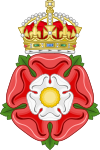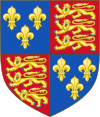Benutzer:HybridExplorer/The Queen's Beasts
Bei den Queen's Beasts handelt es sich um zehn heraldische Figurengruppen. Sie stellen die tierischen Schildhalter der Wappen und Badges englischer Könige und Dynastien dar. Sie repräsentieren die Ahnenreihe von Königin Elizabeth II. seit dem 14. Jahrhundert und wurden anlässlich ihrer Krönung 1953 von geschaffen und vor dem provisorischen westlichen Anbau der Westminster Abbey aufgereiht.[1]
Als Vorbild dienten die Kings's Beasts, eine vergleichbare Figurengruppe entlang der westlichen Zufahrt des Hampton Court Palace. Sie stehen jedoch für die Ahnenreihe von König Heinrich VIII. und seiner dritten Frau Jane Seymour und sind somit nicht identisch mit den Queen's Beasts, die keine Nachfahrin dieser Verbidnung ist. Auch auf den Fialen der St George’s Chapel in Windsor Castle befinden sich ebenfalls ...
Die Queen's Beasts befinden sich heute Canadian Museum of History
In 1953 the country witnessed the coronation of Her Majesty The Queen. Standing guard outside Westminster Abbey were ten statues of heraldic beasts, imposing symbols of royal authority. The Queen’s Beasts Collection from The Royal Mint celebrates each of these creatures in turn. As we reach the sixth coin in the series, we’re excited to present the Yale of Beaufort, the latest coin to be released.
Mythical and regal, the yale follows the Red Dragon of Wales and the Black Bull of Clarence, which were released in 2018, the year of the 65th anniversary of the coronation of The Queen. The yale was described in ancient times as the size of a hippopotamus with the tail of an elephant, the jaws of a boar and of a black or tawny colour. It descends to The Queen through Henry VII, who inherited it from his mother, Lady Margaret Beaufort, who had played a central role in the Wars of the Roses. Her position as matriarch of the Tudor dynasty gave the yale prestige and symbolic meaning.
There are ten heraldic beasts of a very like sort at Hampton Court Palace near London. They were restored at the beginning of the twentieth century but were derived from originals made more than 400 years ago for Henry VIII, and are generally called 'the King's Beasts'. They are carved in stone and each sits erect, supporting a shield upon which there is a coat of arms or a heraldic badge. From the beasts themselves and the emblems which they carry on their shields it is evident that they stood for King Henry and his third Queen, Jane Seymour.
In the autumn of 1952, the Minister of Works, in preparation for the great event some months ahead, called upon the Royal Academician and sculptor James Woodford, OBE, to create ten new beasts similar in form and character to the ten at Hampton Court but more particularly, appropriate to the Queen. Exact replicas of those at Hampton Court would have been unsuitable for the occasion, for some of them would have little connection with Her Majesty's own family or ancestry.
The Queen's Beasts are ten heraldic statues representing the genealogy of Queen Elizabeth II, depicted as the Royal supporters of England. They stood in front of the temporary western annexe to Westminster Abbey for the Queen's coronation in 1953. Each of The Queen's Beasts consists of an heraldic beast supporting a shield bearing a badge or arms of a family associated with the ancestry of Queen Elizabeth II. They were commissioned by the British Ministry of Works from sculptor James Woodford (who was paid the sum of £2,750 for the work). They were uncoloured except for their shields at the coronation.
They are now on display in the Canadian Museum of History.
There are other statues of the Queen's Beasts, sometimes referred to as the King's Beasts, at Hampton Court Palace and Kew Gardens in London, and on the roof of St George's Chapel, Windsor Castle.
https://www.royalmint.com/stories/collect/The-Queens-Beasts-A-Story-of-Royal-Heraldry-and-Heritage/
| Schildhalter | Wappen | Beschreibung |
|---|---|---|
 |
 |
Der bekrönte goldene Löwe von England dient seit der Herrschaft Eduard IV. als Schildhalter des englisches Wappens. Das Wappenschhild entspricht dem Wappen des Vereinigten Königreichs, wie es Königin Victoria 1837 einführte. |
 |
 |
Der weiße Greyhound der Earls of Richmond entstammt dem Wappen von Edmund Tudor, 1. Earl of Richmond. Er hält ein weiß-grün geteilten Schild mit der Tudor-Rose. |
 |
 |
Das Yale der Beauforts
Fallgatter The white and gold-spotted Yale of Beaufort has such horns along with the whiskers or ‘tushes’ of a boar. It descends to The Queen through Henry VII, who inherited it from his mother, Lady Margaret Beaufort, who had played a central role in the Wars of the Roses. Her position as matriarch of the Tudor dynasty gave the yale prestige and symbolic meaning. The Yale of Beaufort was a symbol of Lady Margaret Beaufort, mother of Henry VII. The Yale of The Queen’s Beasts holds a shield with the blue and white quarters of Margaret’s arms but with a golden portcullis at the centre, a badge used by Henry VII. The portcullis is also part of the arms of Westminster City Council, which is home to Westminster Abbey where the coronation took place in 1953. |
 |
 |
Der rote walisische Drache
In Wales it was mentioned in chronicles as early as the sixth century, sometimes known as the red dragon of Cadwallader, the legendary king of Gwynedd. The Red Dragon of The Queen’s Beasts was an emblem of Owen Tudor, a claim to Welsh heritage that was carried on by his son, who would become Henry VII. The troops of Henry VII carried a fiery red dragon standard at the Battle of Bosworth, when Henry secured the crown of England. Henry VIII used a red dragon on green and white – the colours of the House of Tudor – on his ships. It was an official emblem of Wales for many years but it was not until 1959 that The Queen made the red dragon on a green and white background the official flag for Wales. The dragon of The Queen’s Beasts is red with a yellow underbelly and it holds a quartered red and gold shield with leopards, the arms of Llewelyn ap Griffith, the last native prince of Wales. |
 |
 |
Das weiße Ross des Hauses Hannover |
 |
 |
Der weiße Löwe des Hauses Mortimer ist im Gegensatz zum goldenen englischen Löwen nicht bekrönt. Er geht auf Eduards IV. Großmutter Anne Moritmer zurück.
The White Lion came to The Queen through Edward IV who inherited the creature from his grandmother, heiress of the Mortimers. Although Edward sometimes used the White Lion as a supporter of his Royal Arms, unlike the Lion of England the White Lion of Mortimer has no crown and its tongue and claws are blue rather than red. In heraldry lions are often ‘rampant’, standing with forepaws raised, but the Lion of Mortimer is often shown sitting rather like a tamed dog with its tail between its legs. The White Lion of The Queen’s Beasts holds a Yorkist shield of blue and ‘murrey’ or mulberry colour with a ‘white rose en soleil’, a white rose on a golden sun, combining emblems that were used by both Edward IV and Richard III. It was a badge used by George VI, The Queen’s father, when he was Duke of York. |
 |
 |
Das schottische Einhorn
Tales of the mythical unicorn date back to around 400 BC, perhaps confused or exaggerated descriptions of animals like the rhinoceros or wild bulls and horses. The creature was at first thought to be huge, strong and fierce, but it later became a more elegant beast, a symbol of purity and innocence. James I of England, who united the English and Scottish thrones, chose the Scottish Unicorn to join the Lion of England in supporting the Royal Arms. They have supported the shield ever since. The Unicorn of Scotland, milk-white with gold hooves, horn and mane, has a coronet around its neck, like a collar, with a gold chain attached. It is thought that the chain was to show a great beast had been tamed to serve the king. As with most chained beasts in heraldry, its strength is emphasised rather than diminished by its shackles. It holds the royal coat of Scotland, unchanged since the time of Scottish king, Alexander III. A red lion rampant (the most fierce stance) is shown on a gold background. |
 |
 |
Der Greif von Eduard III. |
 |
 |
Der schwarze Stier der Dukes of Clarence
The Black Bull of Clarence is a ‘Yorkist’ beast which came to The Queen through Edward IV, the first king of England from the House of York and one of the key players in the ‘Wars of the Roses’. Assisted by the Earl of Warwick who was known as the ‘kingmaker’, Edward took power from Henry VI, overturning a troubled Lancastrian rule. Henry VI fled to Scotland, but later briefly returned to the throne before he was finally defeated in battle by Edward in 1461. His execution at the Tower left no doubt over the new king’s reign. Edward IV is said to have often used the bull as a symbol, as did his brother, Richard III, the last York king. Edward’s original claim to the throne was as the great-grandson of Roger Mortimer, descendent of the Duke of Clarence, who Richard II had named as his successor but who was usurped by his nephew, Henry IV. At The Queen’s coronation the Black Bull of Clarence held a shield with the Royal Arms as they were borne for more than 200 years, not only by the Yorkist kings but by the Lancastrians that went before and the Tudors who came after. The shield has two quarters with the gold lions of England, adopted by Richard I, and two with the golden lilies of France, added by Edward III to support his claim to the French throne. |
 |
 |
Der Falke des Hauses Plantagenet
The Falcon passed to The Queen from the Plantagenet king Edward III. He chose the symbol to embody his love of hawking but it is also closely associated with his great-great-grandson, Edward IV. The white Falcon at The Queen’s coronation held a shield with a badge depicting a second white falcon within an open golden ‘fetterlock’ or padlock. The fetterlock and the falcon were popular emblems in the Houses of both York and Lancaster, as they had descended from Edward III’s younger sons John of Gaunt and Edmund of Langley. The fetterlocks used by John and Edmund were always locked, perhaps to show they had no claim to the throne. Edward IV gave his younger son, Richard, the badge of a white falcon within an open fetterlock – the lock Edward forced to take the throne. Henry VII, who united the houses of York and Lancaster with his marriage to Elizabeth of York, often used a falcon symbol and it was said to be the favourite badge of Queen Elizabeth I |
- ↑ Elizabeth II. In: www.westminster-abbey.org. Abgerufen am 4. Juli 2020 (englisch).